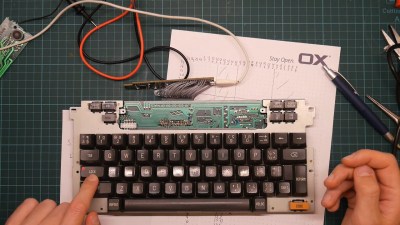Back before there were laptops and subsequently, netbooks, there were these adorable thermal typewriter/word processors that are lovingly referred to by their fans as baby wedges or wedgies. These fascinating little machines can put words on paper two different ways: you can either use a prohibitively expensive little ribbon cartridge and regular copy paper, or you can go the easy route and get yourself a 96′ roll of thermal fax paper and type until you feel like tearing off the page.
[David] was lucky enough to pick up a Canon S-70 in working condition for next to nothing, thinking it would make an awesome USB keyboard, and we agree. The PSoC 5 that now controls it may be overkill, but it’s pretty affordable, and it was right there on the desk just waiting for a purpose. And bonus — it has enough I/O for all of those loud and lovely keyswitches.
 One thing that keeps these baby wedges within the typewriter camp is the Shift Lock function, which can only be disengaged by pressing Shift and had its own discrete logic circuitry on the board before he was forced to remove it.
One thing that keeps these baby wedges within the typewriter camp is the Shift Lock function, which can only be disengaged by pressing Shift and had its own discrete logic circuitry on the board before he was forced to remove it.
That little screen is pure word processor and was used to show the typing buffer — all the characters you have a chance to correct before the print head commits them to paper. In a win for word processors everywhere, the screen was repurposed to show the current word count.
He was kind enough to post his firmware as well as real-time footage of the build. Watch him demo it in the wild after the break, and then stick around for part one of the build saga.
Portable word processors were still being made ten years ago, though they were mostly aimed at the primary school market as keyboarding trainers. Our own [Tom Nardi] recently did a teardown of a model called The Writer that relies on IR to send files.
Continue reading “Hacker Turns Thermal Clacker Into USB Keyboard” →














